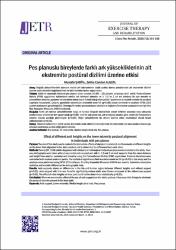| dc.contributor.author | Şahin, Mustafa | |
| dc.contributor.author | Algun, Zeliha Candan | |
| dc.date.accessioned | 2021-02-04T11:51:31Z | |
| dc.date.available | 2021-02-04T11:51:31Z | |
| dc.date.issued | 2020 | en_US |
| dc.identifier.citation | Şahin, M. ve Algun, Z. C. (2020). Pes planuslu bireylerde farklı ark yüksekliklerinin alt ekstremite postüral dizilimi üzerine etkisi. Journal of Exercise Therapy and Rehabilitation (JETR), 7(2), 154-158. | en_US |
| dc.identifier.issn | 2148-8819 | |
| dc.identifier.uri | https://hdl.handle.net/20.500.12511/6515 | |
| dc.description.abstract | Amaç: Değişik yüksekliklerdeki standart medial ark takviyelerinin statik ayakta durma postüründeki alt ekstremite dizilimi üzerine anlık etkilerini değerlendirmek ve birbirlerinden farkını saptamaktır. Yöntem: Klinik ve radyolojik bilateral pes planus tanısı konulan 20 (9K, 11E) yetişkin çalışmaya dahil edildi. PostureScreen Mobile (PSM) uygulaması kullanılarak medial ark takviyesi olmadan ve 1, 1,5 ve 2 cm ark takviyesi ile aynı mesafe ve yükseklikten anterior, posterior ve lateralden olmak üzere 4 yönlü fotoğrafları çekildi. İşaretlenen anatomik noktalar ile postüral sapmalar hesaplandı. Çalışma genelinde istatistiksel anlamlılık sınırı %5 (p<0,05) olarak belirlendi ve analizler SPSS 22.0 yazılımı kullanarak gerçekleştirildi. Demografik veriler için tanımlayıcı istatistik ve değişken farklarının saptanabilmesi için One Way Repeated Measures ANOVA kullanıldı. Bulgular: Farklı ark takviye yüksekliklerinin kalça ve lumbar bölgede istatistiksel olarak birbirleri arasında veya takviyesiz postüre karşı anlamlı bir fark yaratmadığı (p>0,05), 1cm’lik takviyenin ise, ark takviyesiz postüre göre, statik diz fleksiyonunu anlamlı oranda azalttığı görülmüştür (p<0,05). Diğer yüksekliklerin diz eklemi üzerine etkisi istatistiksel olarak tespit edilememiştir (p>0,05). Sonuç: Tabanlık kullanımının statik postür üzerindeki anlık etkisini incelediğimizde diz ekleminde var olan postüral bozukluğu ortadan kaldırmaya yardım ettiği görülmektedir. | en_US |
| dc.description.abstract | Purpose:The aim of this study was to evaluate the immediate effects of standard medial arch reinforcements at different heights on the lower limb alignment in the static posture and to determine the difference from each other. Methods:Twenty (9F, 11M) adults diagnosed with clinical and radiological bilateral pes planus were included in the study. Fourway photographs were taken without any medial arch support and with 1, 1.5 and 2 cm arch supports from the same distance and height from anterior, posterior and lateral by using the PostureScreen Mobile (PSM) application. Postural deviations were calculated with marked anatomic points. The statistical significance limit was determined as 5% (p <0.05) in this study and the analyzes were performed using SPSS 22.0 software. One Way Repeated Measures ANOVA was used to determine descriptive statistics and variable differences for demographic data. Results: Arch supports shown no differences in the hip and lumbar region between different heights and without support (p>0,05). Arch support with 1cm was found to significantly reduce static knee flexion compared to the without any support (p<0,05). The effect of other heights on knee joint could not be determined statistically (p>0,05). Conclusion: When we examine the effect of the use of arch supports on the static posture, it has seen that it helps to eliminate the postural disorder present in the knee joint. | en_US |
| dc.language.iso | tur | en_US |
| dc.rights | info:eu-repo/semantics/openAccess | en_US |
| dc.subject | Ark Desteği | en_US |
| dc.subject | Alt Ekstremite | en_US |
| dc.subject | Medial Longitudinal Ark | en_US |
| dc.subject | Pes Planus | en_US |
| dc.subject | Arch Support | en_US |
| dc.subject | Lower Extremity | en_US |
| dc.subject | Medial Longitudinal Arch | en_US |
| dc.subject | Pes Planus | en_US |
| dc.title | Pes planuslu bireylerde farklı ark yüksekliklerinin alt ekstremite postüral dizilimi üzerine etkisi | en_US |
| dc.title.alternative | Effect of different arch heights on the lower extremity postural alignment in individuals with pes planus | en_US |
| dc.type | article | en_US |
| dc.relation.ispartof | Journal of Exercise Therapy and Rehabilitation (JETR) | en_US |
| dc.department | İstanbul Medipol Üniversitesi, Sağlık Bilimleri Fakültesi, Fizyoterapi ve Rehabilitasyon Bölümü | en_US |
| dc.department | İstanbul Medipol Üniversitesi, Tıp Fakültesi, Cerrahi Tıp Bilimleri Bölümü, Ortopedi ve Travmatoloji Ana Bilim Dalı | en_US |
| dc.authorid | 0000-0002-5792-5755 | en_US |
| dc.authorid | 0000-0002-2476-6567 | en_US |
| dc.identifier.volume | 7 | en_US |
| dc.identifier.issue | 2 | en_US |
| dc.identifier.startpage | 154 | en_US |
| dc.identifier.endpage | 158 | en_US |
| dc.relation.publicationcategory | Makale - Ulusal Hakemli Dergi - Kurum Öğretim Elemanı | en_US |


















